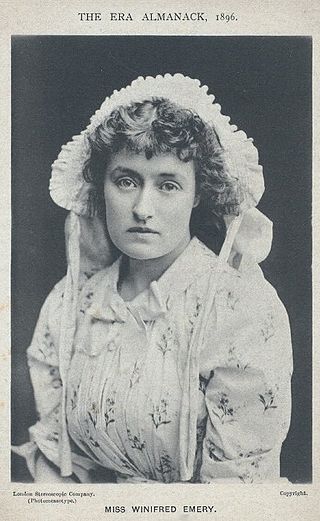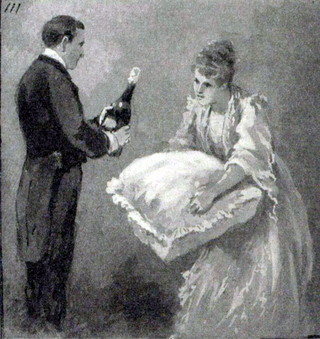
Die Fledermaus is an operetta composed by Johann Strauss II to a German libretto by Karl Haffner and Richard Genée, which premiered in 1874.

Sir Arthur Wing Pinero was an English playwright and, early in his career, actor.

The Second Mrs. Tanqueray is a problem play by Arthur Wing Pinero. It utilises the "Woman with a past" plot, popular in nineteenth century melodrama. The play was first produced in 1893 by the actor-manager George Alexander and despite causing some shock to his audiences by its scandalous subject it was a box-office success, and was revived in London and New York in many productions during the 20th century.

Dulcie Winifred Catherine Savage Denison,, known professionally as Dulcie Gray, was a British actress, mystery writer and lepidopterist.

Dame Irene Vanbrugh DBE was an English actress. The daughter of a clergyman, Vanbrugh followed her elder sister Violet into the theatrical profession and sustained a career for more than 50 years.

Julia Emilie Neilson was an English actress best known for her numerous performances as Lady Blakeney in The Scarlet Pimpernel, for her roles in many tragedies and historical romances, and for her portrayal of Rosalind in a long-running production of As You Like It.

The Private Secretary is an 1883 farce in three acts, by Charles Hawtrey. The play, adapted from a German original, depicts the vicissitudes of a mild young clergyman, innocently caught up in the machinations of two irresponsible young men who are bent on escaping their creditors.

Violet Vanbrugh, born Violet Augusta Mary Barnes, was an English actress with a career that spanned more than 50 years. Despite her many successes, her career was overshadowed by that of her more famous sister, Dame Irene Vanbrugh.

Those Were the Days is a 1934 British comedy film directed by Thomas Bentley and starring Will Hay, Iris Hoey and John Mills. It was based on Arthur Wing Pinero's 1885 farce The Magistrate and was the first of two Hay movies based on Pinero's plays, the other being Dandy Dick. The film also features music hall acts of the time – acts of a type rarely committed to film. It is primarily remembered as Will Hay's first major screen role.

The Globe was a Victorian theatre built in 1868 and demolished in 1902. It was the third of five London theatres to bear the name, following Shakespeare’s Bankside house, which closed in 1642, and the former Rotunda Theatre in Blackfriars Road, which for a few years from 1833 was renamed the Globe. The new theatre was also known at various times as the Royal Globe Theatre or Globe Theatre Royal. Its repertoire consisted mainly of comedies and musical shows.

Toole's Theatre, was a 19th-century West End building in William IV Street, near Charing Cross, in the City of Westminster. A succession of auditoria had occupied the site since 1832, serving a variety of functions, including religious and leisure activities. The theatre at its largest, after reconstruction in 1881–82, had a capacity of between 650 and 700.

Arthur Cecil Blunt, better known as Arthur Cecil, was an English actor, comedian, playwright and theatre manager. He is probably best remembered for playing the role of Box in the long-running production of Cox and Box, by Arthur Sullivan and F. C. Burnand, at the Royal Gallery of Illustration.

Lottie Venne was a British comedian, actress and singer of the Victorian and Edwardian eras, who enjoyed a theatre career spanning five decades. Venne began her stage career in musical burlesque before moving into farce and comedy. She appeared in several works by each of F. C. Burnand and W. S. Gilbert and was often in plays with Charles Hawtrey later in her career.

The Magistrate is a farce by English playwright Arthur Wing Pinero. It concerns a respectable magistrate who finds himself caught up in scandalous events that threaten to disgrace him.

Dandy Dick is a three-act farce by Arthur Wing Pinero, first performed in London in 1887. It depicts the complications arising when a respectable clergyman is persuaded to bet on a horse race to subsidise building works on his church. The play has been revived several times and has been adapted for the cinema, radio and television.

Winifred Emery was an English actress and actor-manager of the late 19th and early 20th centuries. She was the wife of the actor Cyril Maude.

The Gay Lord Quex is an 1899 comedy play by the British playwright Arthur Wing Pinero. It depicts the vicissitudes of a reformed philanderer attempting to embark on monogamy. The original production provoked controversy, some critics finding the plot at best questionable and at worst immoral.

The Pink Dominos is a farce in three acts by James Albery based on the French farce Les Dominos roses by Alfred Hennequin and Alfred Delacour. It concerns a plan by two wives to test their husbands' fidelity at a masked ball and a mischievous maid who causes comic complications by wearing a gown similar to those worn by the wives. The "dominos" of the title are gowns with hoods and masks, worn at masquerades. The piece opened on March 31, 1877 and was exceptionally successful, running for a record-setting 555 performances. Charles Wyndham played one of the husbands and produced the piece at the Criterion Theatre. Augustus Harris played Henry and Fanny Josephs was one of the wives.

A Cuckoo in the Nest is a farce by the English playwright Ben Travers. It was first given at the Aldwych Theatre, London, the second in the series of twelve Aldwych farces presented by the actor-manager Tom Walls at the theatre between 1923 and 1933. Several of the cast formed the regular core cast for the later Aldwych farces. The plot concerns two friends, a man and a woman, who are each married to other people. While travelling together, they are obliged by circumstances to share a hotel bedroom. Everyone else assumes the worst, but the two travellers are able to prove their innocence.

John Alfred Calthrop known as John Clayton was an English actor. After building a career in a range of parts, he became best known for his roles in the farces of Arthur Wing Pinero. With Arthur Cecil he was joint manager of the Court Theatre in London from 1883 until his death, aged 43, while on tour in Liverpool.




















